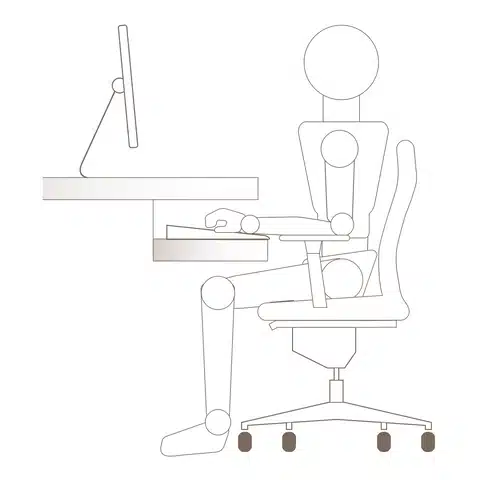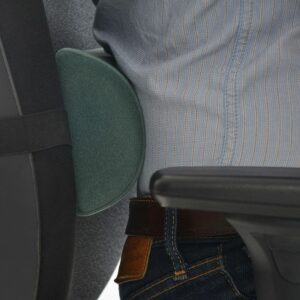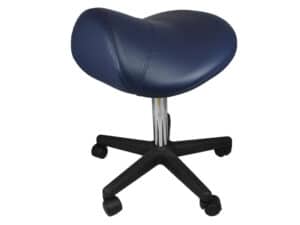By Andrew Siyabalawatte and Sumaiya Farheen, Sept 2023.
In our modern era of prolonged desk work and screen time, back pain has become a common issue. Surprisingly, the very same ergonomic principles that ease desk-related discomfort can also assist you in tackling the challenges of hilly terrain.

In this unique guide, we’ll explore how to eliminate back pain both at your desk and while conquering inclines, offering you the ultimate path to ergonomic euphoria.
What Is An Ergonomic Desk?
An ergonomic desk is designed to prevent working at an uncomfortable angle, which over time would load significant pressure unevenly throughout the body, increasing the likelihood of developing poor posture and injury.
An optimal ergonomic desk set up will help prevent common injuries such as repetitive strain injury, carpal tunnel syndrome, upper limb discomfort, elbow pain, neck pain, and back pain.

Ergonomic Sitting To Help Prevent Back Pain
Sitting correctly and protecting the lumbar spine can lead to improvements throughout the whole spine and even your head and neck position too.
The slightly down thigh posture with slightly anterior pelvic tilt can take the stress off the joints in the lower back and place the discs in their middle position, which helps keep the back healthy and prevent injury, whilst also easing ongoing back problems.

When sitting in the forward tilting seat position there is actually no need for the use of a back rest on the chair, which is why many ‘ergonomic’ chairs do not have a back rest at all. Examples of ergonomic chairs that use this type of posture include: the kneeling chair and the saddle chair.
The Difference Between A Kneeling and Saddle Chair
The differences between kneeling chairs and saddle chairs are what matters the most to you. Saddle chairs offer far more freedom for the movement of your legs as the design in kneeling chairs, constrain your legs.
Saddle chairs are also easier to use in a workspace. If the saddle chair is set up at the appropriate height, you can essentially still walk around while using it, whereas with a kneeling chair, you’re stuck in one place.
Most importantly, saddle chairs do not have a downside to using them. They help you preserve a healthy spine and posture without adding unnecessary pressure on other parts of your body.
Back Support For An Office Chair
Lumbar support pillows help to ease back pain and offer support, allowing the spine to remain in a natural position, when sitting or lying on the back.

Our choice of lumbar support is the Original McKenzie D-Section Lumbar Roll. Resting against the D-shaped pillow improves posture and helps to correct mechanical back pain.
Ergonomic Mesh Office Chair
A popular choice, the mesh office chairs provide comfort and support, with adjustable height and reclining features. The most desirable feature is the breathable fabric that keeps you cool & comfortable all day.
In our opinion, whilst the mesh office chair is well built, it is not our go to choice to maintain good posture in a desk based environment for the long term. This is because the mesh may lose elasticity over time and begin to sag leading to uncomfortable sitting postures, which may potentially lead to back problems in the future.
What Is A Good Ergonomic Stool For Sitting?
This saddle stool by Physique, offers a comfortable seating option with its 45cm padded seat, which helps to keep your pelvis in a slightly forward position. This position will keep the lower spine in a naturally curved position, as well as provide support to your legs, reducing joint and muscle pressure, making it perfect for sitting and standing up frequently when you work throughout the day.

The Best Foot Rest
A good foot rest is one that elevates your feet at varying inclines, dependable on your ideal sitting position. If used correctly, it can help to reduce back strain by aligning posture, ultimately unloading undue weight off the feet, ankles, knees, and thighs.
Why Is Sitting With Crossed Legs So Comfortable?
Crossing our legs fixes our pelvis, stopping it from moving too much, which can take the strain off the lower back as our lumbar spine is more supported.
Though repeated crossing of the legs can be comfortable, it can also become a bad habit, one that might affect your posture in the long term. Why? Well, you can only cross one leg at a time, which, repeatedly done can lead to imbalances developing within the spine and pelvis over time.
To help with preventing this, we recommend getting up from your chair or desk and moving every 30 minutes. This practice, will help to cultivate a new habit as you become more aware of your posture.
The Ideal Sitting Position When Driving A Car
Check the angle of the back seat, if you recline too far you’ll have to bend your neck and upper back forward too much to see where you are driving. Then adjust the lumbar support (use a pillow if your car does not have this feature) where possible so it comfortably fills the arch of your back. This can really support your back and help with lower back pain. Your hips should be at least as high as your knees.

If your hips are too low after adjusting the seat, try adding a cushion or a wedge (use a folded towel if you do not have a cushion or a wedge). The seat wedge will relieves the stress on the lower back in a natural way by pushing the pelvis forward and automatically causing your knees to be lower than your hips.
This position encourages your back to an upright posture and your spine to assume its natural shape. Cushions also decrease vibrations from the road which have been shown to contribute to injuries.
5 Tips For Better Health, Everyday
Lifestyle Choices- Beyond the desk and hills, carry ergonomic wisdom into your daily life. Maintain good posture while sitting, walking, and lifting objects.
Exercise Routine- Regularly engage in exercises that strengthen your core and leg muscles, promoting overall stability and reducing the risk of back pain.
Consistency is Key- Whether you’re at your desk or conquering hills, consistency is the key to ergonomic success. Make these practices a part of your daily routine.

Proper Sitting Posture- Maintain a posture that supports the natural curve of your spine. Ensure your feet are flat on the floor, knees at a 20-30 degrees lower than the hips, and your monitor at eye level.
Regular Breaks- Stand up, stretch, and walk around every 30 minutes to alleviate the pressure on your lower back. This simple habit can work wonders.
Consult with our Experts, if you struggle with chronic back pain, consider consulting with ergonomic specialists or physical therapists for personalized guidance.
As you journey through the realms of work and leisure, remember that ergonomic euphoria is within reach. By optimizing your desk setup, mastering hill-walking techniques, and embracing ergonomic principles in your daily life, you can bid farewell to back pain and savor the magic of pain-free workdays. After all, what goes up doesn’t have to come down with discomfort.

